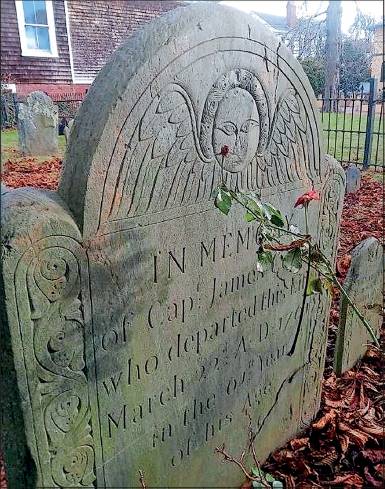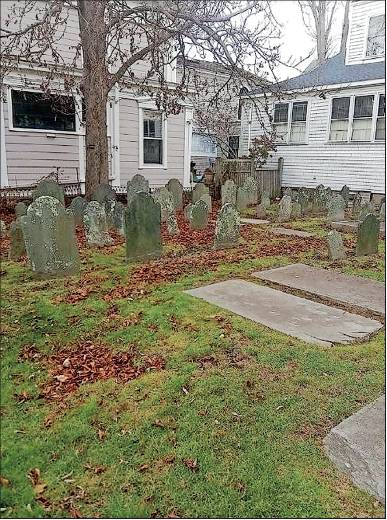NEWPORT
Stories amid the stones: Arnold Burying Ground
By Laura Damon Daily News Staff Writer
NEWPORT — Some of the headstones in the Arnold Burying Ground face west, a sign that the dead beneath them face east, in the direction of the rising sun.
Such a burial and marker pattern was common in colonial-era Newport, according to Lew Keen, chairman of the Newport Historic Cemetery Advisory Commission, an organization that helps the city to conserve and maintain local historic cemeteries. As a reflection of their faith, the dead face east toward the rising sun, which symbolized the resurrection of Jesus Christ, Keen said.
Not all of the stone inscriptions face west, though, and Keen, standing in the burial ground on a recent Thursday, couldn’t say why that was; it could be due to the stone moving and re-interments that occurred on the site, creating the hodgepodge state it’s in today.
Tucked a few yards away from the traffic on Pelham Street, the Arnold Burying Ground was established by Benedict Arnold (1615-1678), the first governor of Rhode Island under the Royal Charter of 1663, as a burial ground for his family. The stones, coffins and bones were removed to the Common Burying Ground by the owner of the land in 1857 as part of a plan to convert the site to a new use. Public outcry halted the project, and all but two stones and their remains were returned to the original lot. But the stones were not arranged to mirror their previous state; many were buried in a pit and eventually a cottage was built over them.
By 1946, the cottage had fallen into disrepair and Alice Brayton, an Arnold descendant, bought the property at an auction. John Howard Benson, another Arnold descendant, headstone carver and owner of the John Stevens Shop — a Newport stone-carving shop established in 1705 by John Stevens — undertook a restoration of the burial ground in 1948.
When Brayton died, the burial ground was deeded to Benson, who left it in his will to the Preservation Society of Newport County, the current owner and maintainer of the land.
Shadows were just beginning to form in the Arnold Burying Ground late Thursday afternoon; the air was cold and the light from the slowly setting sun cast a rose-gold hue on the 53 stones. Some are crooked; some are heavily weathered, while others are legible. There are traditional-looking headstones with shoulders — the two curves on either side of the large center semi-circle — and there are huge, flat rectangular stones engraved with family seals sunk into the ground.
Family burial grounds are common in Rhode Island, Keen said. Arnold was the great-grandfather of the Revolutionary War general of the same name; that Arnold is notoriously remembered as a traitor for betraying the colonial forces by negotiating with and eventually fighting for the British. He is not buried in the Arnold Burying Ground but in England, Keen said.
“I bet 50 bucks this is a William Stevens stone,” Keen said, pointing to a headstone with a winged cherub with eyelashes; he said the eyelash detail is typically characteristic of William Stevens’ craftsmanship. John Stevens employed his sons to work at the John Stevens Shop, and William was one of them. The Stevens carved headstones for a slew of families in Newport.
Some of the large slab stones sunk in the ground have family crests carved into them. A family crest indicates “you were really somebody important,” Keen said. A slab for Benedict Arnold Jr. (1642-1727), eldest son of Gov. Arnold and his wife, Damaris Westcott, boasts the Arnold coat of arms — a marine design that incorporates three scallops.
Though many family burial lots in Newport eventually welcomed members of the family’s congregation, “the Arnolds always stayed family, which is interesting,” Keen said.
Keen said the protection, maintenance and appreciation of historical cemeteries is important because they contain “some of the earliest American art we have.”
The study of local cemeteries yields “lots of lessons to be learned,” Keen said.

